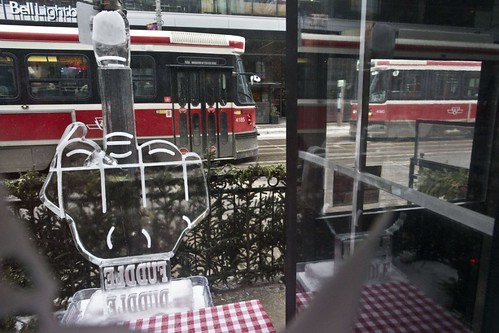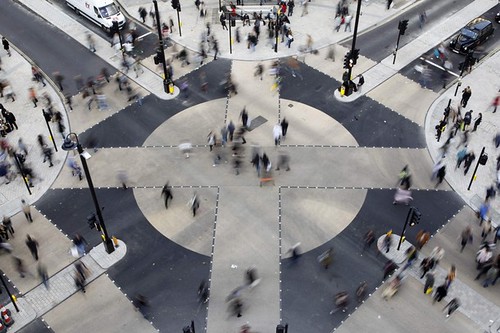Toronto: Vision Zero/Zero Vision?
1. I have written that the King Street streetcar prioritization initiative in Toronto is one of the most important transportation initiatives underway in North America right now, because few cities are so bold as to prioritize transit and total passenger throughput over motor vehicles, because the automobility lobby tends to be vocal and virulent and elected officials tend to defer to the motor car when it comes to policy and counting votes.
The King Street streetcar prioritization is getting pushback from businesses, who have seen a drop off in their night-time business. About 10 days ago, the Mayor launched an "activation program" including ice sculptures and other activities to draw attention to the street with a hope it will stoke business ("Mayor John Tory's plan aims to boost visitors to King St.," Toronto Star) while businesses angry about the change have created ice sculptures "flipping off" the street ("Some businesses give an icy middle finger to King St. pilot," TS).

Businesses protest King Street streetcar prioritization, Toronto
The solution though is pretty simple, which I hope to write up as a letter to the editor or op-ed for the Toronto Star.
2. Early results from the test find a 25% rise in transit use -- to over 80,000 riders per day ("King St. pilot boosting streetcar ridership: TTC," TS). As Star columnist Edward Keenan points out ("King Street pilot project has been a phenomenal success — and brought challenges, to be sure") that's a huge increase in ridership for a cost of $1.5 million (Canadian) as opposed to costs of billions for ill-conceived subway expansions to Scarborough. From the article:
In time, we’ll have reliable numbers for ridership over a sustained period. But if even just this 25 per cent number holds true and is true throughout the day, it’s hard to overstate the level of success that indicates. It would represent an increase of more than 15,000 riders per day, to over 80,000 total riders on one streetcar route. For a change put together in months for an implementation cost of $1.5 million.3. Keenan also writes ("Stop driving children to school: It could be a lifesaver") about driving kids to school -- that people should stop doing so -- in the face of a tragic death on Monday of a 5-year old crushed by a car in a "drop off/pick up zone" outside her elementary school ("Girl dies after being pinned between vehicles while picked up from school").
For comparison purposes: The planned $3-billion-plus subway extension in Scarborough is expected to carry, in 2031, about 15,000 more riders per day than the RT line there today carries (for a total of 64,000). In ridership terms, King Street may be seeing a Scarborough subway’s worth of passenger increase (and much higher total ridership) in just a few weeks, for .05 per cent of the cost.
4. A new campaign on road safety is criticized because 3/4 of the messages focus on pedestrian behavior when 2/3 of the responsibility for crashes is borne by motor vehicle operators ("Police launch safety campaign as traffic deaths spike"). From the article:
Brown argued that although pedestrians have a responsibility to “use common sense and take care,” most people walking on the street won’t deliberately do anything to put themselves in danger.This reminds me of my point about re-engineering road pavements to better fit desired operating speeds.
“You don’t have to make a huge educational effort on that,” he said. “Where the effort should be directed is at drivers of vehicles that don’t understand that travelling at 100 km/h, or 80 km/h, or 50 km/h or 40 km/h even, with a two-tonne vehicle, you’re going to kill somebody. That’s where the effort should be directed.”
-- "The plight of pedestrians," 2014
That's not a response I've seen being developed, although arguably, creating more pedestrianized intersections is a step towards this.

Pedestrian cross the new diagonal crossing at Oxford Circus in London. British Transport Society image.

Mayor John Tory opposes a proposal to cut the stretch of Yonge St. between Sheppard and Finch Sts. down by two traffic lanes to allow for bike lanes and wider sidewalks, despite the local councillor and city staff's approval. (COLE BURSTON / TORONTO STAR)
5. Mayor John Tory doesn't favor the Transform Yonge initiative ("Reimagining Yonge Study Progressing Toward 2018 Final Report, Urban Toronto; "Fight brewing over bike lane location in north Yonge remake," TS), which is focused on better balancing the position of sustainable transportation modes vis a vis cars along with improving the environment for retail and activation on Yonge Street but somewhat distant from the Downtown core. From the article:
Mayor John Tory opposes removing two vehicle lanes on a six-lane stretch of north Yonge St. as part of a plan to build separated bike lanes and wider sidewalks, despite city staff and the local councillor saying that’s the best way to improve the area.Tory’s continued opposition to the “Transform Yonge” plan, after city staff looked at alternatives, is frustrating Councillor John Filion, Ward 23 Willowdale.In general, Mayor Tory's transportation agenda has been more focused on suburban interests, which seem to have the upper hand in Toronto's amalgamated city, although the addition of new council seats in the city's core should help to address that imbalance. See "Three seats being added to Toronto council for the 2018," TS.
“Downtown North York should be more than a sea of highrises with six lanes of highway running down the middle,” said Filion, who will make his case to the public works committee Friday. “This area has been neglected for far too long. The city needs to invest in creating a beautiful (main street) that connects the buildings and the people who live in them.”
The $51.1-million plan would see Yonge from Sheppard Ave. to just north of Finch Ave. get: separated bike lanes on both sides; wider boulevards; better pedestrian crossings; and a landscaped centre median. To make room for cyclists and more sidewalk, one vehicle lane in each direction would be removed between Sheppard and the Yonge intersection with Hendon Ave. on one side and Bishop Ave. on the other.
Labels: bicycle and pedestrian planning, car culture and automobility, sustainable mobility, transportation planning, urban design/placemaking



3 Comments:
To clarify: the 25% increase in King Street transit users is "based on an observed increase in volume from 2,100 passengers to 2,600 passengers eastbound at the peak location of Spadina Avenue" [https://www.toronto.ca/wp-content/uploads/2018/01/946a-KSP_Dec-2017-Dashboard-Update.pdf], i.e. a single point. We cannot extrapolate at this time to 25% more all-day riders along the whole line.
Thanks.
2. tickets to drivers going through an intersection when signs tell them they have to turn:
https://www.thestar.com/news/gta/2018/04/06/more-than-4500-tickets-issued-to-drivers-disobeying-king-st-pilot-rules.html
Ryerson U professor supported but not retained by the restaurants, says that the gains from the pilot are modest:
https://www.thestar.com/news/gta/transportation/2018/03/26/ryerson-transit-expert-challenges-the-ttcs-findings-on-the-king-st-pilot-project.html
Post a Comment
<< Home